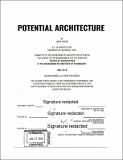Potential architecture
Author(s)
Minor, Jason (Jason S.)
DownloadFull printable version (33.48Mb)
Other Contributors
Massachusetts Institute of Technology. Department of Architecture.
Advisor
William O'Brien Jr.
Terms of use
Metadata
Show full item recordAbstract
Material equality, and thus the balance of social power, represents an Inherently architectural problem. But architects do not yet possess the tools required to formulate a meaningful response. Architects should be painfully aware that building - In a society that relies on capitalist principles - is almost always the product of some form of real estate exploitation. Georg Simmel, In his sociological analysis of money, emphasizes its objective spirit - money institutionalizes and structures the entire social terrain. In this formula the contemporary architect Is not near a position of power in the world. In an era of widening social and spatial inequality, what roles - If any - are available for an architect to play in addressing the difficulties of real estate as authored predominantly by architects? Rather than impotently brooding, this project treads stubbornly towards a hopeful function for the architect as an agent of social injustice - even if that requires thinking through new temporalities of design. If the influx of global capital Into New York City property cannot be stopped perhaps architects should seek out opportunistic misadventures. Potential Architecture plays by all the rules of late-late capitalism, but seeks new structures, patterns, and possible disturbances by fabricating the construction (and destruction) of a tower designed for a New York elite that exists beyond democracy, transparency, and justice. From a conflicted semi-detached position, perhaps the architectural author has the potential to offer an embedded radicalism. Pushing beyond spectacular opposition architects would construct artifacts of contamination embedded with contradictions. Having the capacity to hold simultaneously opposing states - use and exchange value, resistance and cooperation, independence and regulation - is what at this moment grants architecture immense potential.
Description
Thesis: M. Arch., Massachusetts Institute of Technology, Department of Architecture, 2018. Cataloged from PDF version of thesis. "June 2018." Includes bibliographical references (page 99).
Date issued
2018Department
Massachusetts Institute of Technology. Department of ArchitecturePublisher
Massachusetts Institute of Technology
Keywords
Architecture.